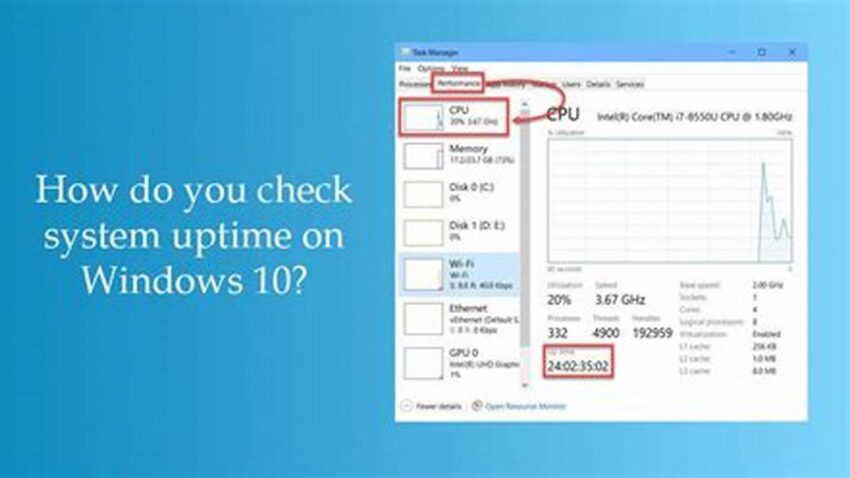Knowing how long a Windows system has been running continuously can be valuable for troubleshooting, performance analysis, and system maintenance. This information can reveal instability issues, the impact of recent updates, or simply provide a general overview of system activity. Several methods offer quick and easy access to this data.
Task Manager
The Task Manager provides a readily accessible view of system uptime. Open Task Manager (Ctrl+Shift+Esc), navigate to the “Performance” tab, and locate the “Uptime” value.
Command Prompt
The `systeminfo` command in the Command Prompt displays a wealth of system information, including uptime. Open Command Prompt (search for “cmd”) and type `systeminfo`. Look for the “System Boot Time” entry.
PowerShell
PowerShell offers similar functionality. Open PowerShell (search for “powershell”) and enter the command `(Get-Date) – (Get-Ciminstance -ClassName Win32_OperatingSystem).LastBootUpTime`. This calculates the difference between the current time and the last boot time, providing the uptime.
System Information (msinfo32)
The System Information tool (msinfo32.exe) provides a comprehensive overview of system details. Access it by searching for “msinfo32” in the Start Menu. The “System Boot Time” field displays the time the system was last started.
WMI (Windows Management Instrumentation)
WMI provides programmatic access to system information. Using scripts or tools that leverage WMI, the uptime can be retrieved and used for automated tasks or monitoring.
Event Viewer
While not directly displaying uptime, the Event Viewer logs system events, including startups and shutdowns. Analyzing these events can provide insight into uptime and potential issues related to system stability.
Performance Monitor
The Performance Monitor allows tracking of various system metrics, including uptime. This is particularly useful for monitoring trends and identifying potential performance bottlenecks related to extended uptime.
Third-Party Tools
Various third-party system information and monitoring tools offer convenient access to uptime information, often alongside other useful system metrics.
Network Monitoring Tools
Some network monitoring tools can track device uptime, including Windows systems. This can be valuable in network administration for identifying potential issues and planning maintenance.
Tips for Using Uptime Information
Regularly checking uptime can help identify patterns related to system instability. Unexpectedly short uptimes might indicate underlying hardware or software problems.
Compare uptime with the installation dates of software or updates. This can help isolate the cause of new issues that arise after system changes.
Long uptimes aren’t necessarily problematic but can sometimes lead to performance degradation. Consider periodic restarts to clear temporary files and refresh system resources.
Documenting uptime after major system changes or updates creates a valuable record for future troubleshooting.
Why is knowing system uptime important?
System uptime can help diagnose instability issues, assess the impact of updates, and provide a general understanding of system activity.
How often should I check system uptime?
Regular checks, particularly after updates or troubleshooting, are beneficial. Consistent monitoring can reveal patterns indicative of underlying issues.
Is long uptime bad for my system?
While not inherently harmful, extended uptimes can sometimes lead to performance degradation due to accumulated temporary files and resource exhaustion. Periodic restarts are recommended.
Can I automate the monitoring of system uptime?
Yes, using scripting languages like PowerShell or WMI, or utilizing third-party monitoring tools, uptime can be automatically tracked and logged.
What if my system shows very short, frequent uptimes?
This often indicates a problem, such as a failing hardware component or a software conflict causing crashes. Further investigation is recommended.
Are there security implications related to long uptimes?
While not directly a security risk, long uptimes can increase the potential impact of a successful exploit. Regular patching and updates mitigate this risk, and planned reboots allow for these updates to be applied.
Understanding and utilizing system uptime information provides valuable insights into system performance and stability, aiding in proactive maintenance and effective troubleshooting.

